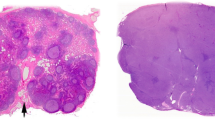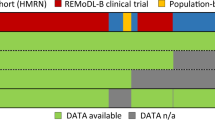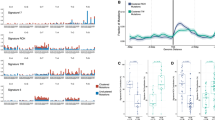Abstract
CHK1 gene encodes for a serine/threonine kinase involved in the regulation of cell cycle progression and DNA damage checkpoints. To determine the role of CHK1 in the pathogenesis of lymphoid neoplasms and its relationship to other DNA damage response genes, we have analyzed the gene status, protein, and mRNA expression in a series of tumors and nonneoplastic lymphoid tissues. CHK1 protein and mRNA expression levels were very low in both reactive tissues and resting lymphoid cells, whereas tumor samples showed a variable pattern of expression related to their proliferative activity. However, seven aggressive tumors showed a dissociate pattern of extremely low or negative protein expression in spite of a high proliferative activity. Four of these tumors were diffuse large B-cell lymphomas (DLCLs) with concordant reduced levels of mRNA, whereas one blastoid mantle cell lymphoma (B-MCL) and two DLCLs had relatively normal levels of mRNA. No gene mutations, deletions, or hypermethylation of the promoter region were detected in any of these cases. In all these tumors ATM, CHK2, and p53 genes were wild type. These findings suggest that CHK1 inactivation in NHLs occurs by loss of protein expression in a subset of aggressive variants alternatively to ATM, CHK2, and p53 alterations.
This is a preview of subscription content, access via your institution
Access options
Subscribe to this journal
Receive 12 print issues and online access
$259.00 per year
only $21.58 per issue
Buy this article
- Purchase on Springer Link
- Instant access to full article PDF
Prices may be subject to local taxes which are calculated during checkout




Similar content being viewed by others
References
Nowell PC . Genetic alterations in leukemias and lymphomas: impressive progress and continuing complexity. Cancer Genet Cytogenet 1997; 94: 13–19.
Bea S, Ribas M, Hernandez JM, Bosch F, Pinyol M, Hernandez L et al. Increased number of chromosomal imbalances and high-level DNA amplifications in mantle cell lymphoma are associated with blastoid variants. Blood 1999; 93: 4365–4374.
Bea S, Lopez-Guillermo A, Ribas M, Puig X, Pinyol M, Carrio A et al. Genetic imbalances in progressed B-cell chronic lymphocytic leukemia and transformed large-cell lymphoma (Richter's syndrome). Am J Pathol 2002; 161: 957–968.
Schlegelberger B, Zwingers T, Harder L, Nowotny H, Siebert R, Vesely M et al. Clinicopathogenetic significance of chromosomal abnormalities in patients with blastic peripheral B-cell lymphoma. Kiel-Wien-Lymphoma Study Group. Blood 1999; 94: 3114–3120.
Khanna KK, Jackson SP . DNA double-strand breaks: signaling, repair and the cancer connection. Nat Genet 2001; 27: 247–254.
Camacho E, Hernandez L, Hernandez S, Tort F, Bellosillo B, Bea S et al. ATM gene inactivation in mantle cell lymphoma mainly occurs by truncating mutations and missense mutations involving the phosphatidylinositol-3 kinase domain and is associated with increasing numbers of chromosomal imbalances. Blood 2002; 99: 238–244.
Gronbaek K, Worm J, Ralfkiaer E, Ahrenkiel V, Hokland P, Guldberg P . ATM mutations are associated with inactivation of the ARF-TP53 tumor suppressor pathway in diffuse large B-cell lymphoma. Blood 2002; 100: 1430–1437.
Hangaishi A, Ogawa S, Qiao Y, Wang L, Hosoya N, Yuji K et al. Mutations of Chk2 in primary hematopoietic neoplasms. Blood 2002; 99: 3075–3077.
Stankovic T, Stewart GS, Fegan C, Biggs P, Last J, Byrd PJ et al. Ataxia telangiectasia mutated-deficient B-cell chronic lymphocytic leukemia occurs in pregerminal center cells and results in defective damage response and unrepaired chromosome damage. Blood 2002; 99: 300–309.
Stilgenbauer S, Schaffner C, Litterst A, Liebisch P, Gilad S, Bar-Shira A et al. Biallelic mutations in the ATM gene in T-prolymphocytic leukemia. Nat Med 1997; 3: 1155–1159.
Tort F, Hernandez S, Bea S, Martinez A, Esteller M, Herman JG et al. CHK2-decreased protein expression and infrequent genetic alterations mainly occur in aggressive types of non-Hodgkin lymphomas. Blood 2002; 100: 4602–4608.
Bartek J, Lukas J . Chk1 and Chk2 kinases in checkpoint control and cancer. Cancer Cell 2003; 3: 421–429.
Bertoni F, Codegoni AM, Furlan D, Tibiletti MG, Capella C, Broggini M . CHK1 frameshift mutations in genetically unstable colorectal and endometrial cancers. Genes Chromosomes Cancer 1999; 26: 176–180.
Menoyo A, Alazzouzi H, Espin E, Armengol M, Yamamoto H, Schwartz Jr S . Somatic mutations in the DNA damage-response genes ATR and CHK1 in sporadic stomach tumors with microsatellite instability. Cancer Res 2001; 61: 7727–7730.
Vassileva V, Millar A, Briollais L, Chapman W, Bapat B . Genes involved in DNA repair are mutational targets in endometrial cancers with microsatellite instability. Cancer Res 2002; 62: 4095–4099.
Pinyol M, Hernandez L, Martinez A, Cobo F, Hernandez S, Bea S et al. INK4a/ARF locus alterations in human non-Hodgkin's lymphomas mainly occur in tumors with wild-type p53 gene. Am J Pathol 2000; 156: 1987–1996.
Schaffner C, Idler I, Stilgenbauer S, Dohner H, Lichter P . Mantle cell lymphoma is characterized by inactivation of the ATM gene. Proc Natl Acad Sci USA 2000; 97: 2773–2778.
Rosenwald A, Wright G, Wiestner A, Chan WC, Connors JM, Campo E et al. The proliferation gene expression signature is a quantitative integrator of oncogenic events that predicts survival in mantle cell lymphoma. Cancer Cell 2003; 3: 185–197.
Haruki N, Saito H, Tatematsu Y, Konishi H, Harano T, Masuda A et al. Histological type-selective, tumor-predominant expression of a novel CHK1 isoform and infrequent in vivo somatic CHK2 mutation in small cell lung cancer. Cancer Res 2000; 60: 4689–4692.
Pinyol M, Hernandez L, Cazorla M, Balbin M, Jares P, Fernandez PL et al. Deletions and loss of expression of p16INK4a and p21Waf1 genes are associated with aggressive variants of mantle cell lymphomas. Blood 1997; 89: 272–280.
Herman JG, Graff JR, Myohanen S, Nelkin BD, Baylin SB . Methylation-specific PCR: a novel PCR assay for methylation status of CpG islands. Proc Natl Acad Sci USA 1996; 93: 9821–9826.
Sanchez Y, Wong C, Thoma RS, Richman R, Wu Z, Piwnica-Worms H et al. Conservation of the Chk1 checkpoint pathway in mammals: linkage of DNA damage to Cdk regulation through Cdc25. Science 1997; 277: 1497–1501.
Flaggs G, Plug AW, Dunks KM, Mundt KE, Ford JC, Quiggle MR et al. Atm-dependent interactions of a mammalian chk1 homolog with meiotic chromosomes. Curr Biol 1997; 7: 977–986.
Goff LK, Neat MJ, Crawley CR, Jones L, Jones E, Lister TA et al. The use of real-time quantitative polymerase chain reaction and comparative genomic hybridization to identify amplification of the REL gene in follicular lymphoma. Br J Haematol 2000; 111: 618–625.
Carter TL, Watt PM, Kumar R, Burton PR, Reaman GH, Sather HN et al. Hemizygous p16(INK4A) deletion in pediatric acute lymphoblastic leukemia predicts independent risk of relapse. Blood 2001; 97: 572–574.
Martinez A, Bellosillo B, Bosch F, Ferrer A, Marce S, Villamor N et al. Nuclear survivin expression in mantle cell lymphoma is associated with cell proliferation and survival. Am J Pathol 2004; 164: 501–510.
Vahteristo P, Tamminen A, Karvinen P, Eerola H, Eklund C, Aaltonen LA et al. p53, CHK2, and CHK1 genes in Finnish families with Li-Fraumeni syndrome: further evidence of CHK2 in inherited cancer predisposition. Cancer Res 2001; 61: 5718–5722.
Sanz-Vaque L, Colomer D, Bosch F, Lopez-Guillermo A, Dreyling MH, Bosch F et al. Microsatellite instability analysis in typical and progressed mantle cell lymphoma and B-cell chronic lymphocytic leukemia. Haematologica 2001; 86: 181–186.
Kaneko YS, Watanabe N, Morisaki H, Akita H, Fujimoto A, Tominaga K et al. Cell-cycle-dependent and ATM-independent expression of human Chk1 kinase. Oncogene 1999; 18: 3673–3681.
Lukas C, Bartkova J, Latella L, Falck J, Mailand N, Schroeder T et al. DNA damage-activated kinase Chk2 is independent of proliferation or differentiation yet correlates with tissue biology. Cancer Res 2001; 61: 4990–4993.
Carrassa L, Broggini M, Vikhanskaya F, Damia G . Characterization of the 5′flanking region of the human Chk1 gene: identification of E2F1 functional sites. Cell Cycle 2003; 2: 604–609.
Gatei M, Sloper K, Sorensen C, Syljuasen R, Falck J, Hobson K et al. Ataxia-telangiectasia-mutated (ATM) and NBS1-dependent phosphorylation of Chk1 on Ser-317 in response to ionizing radiation. J Biol Chem 2003; 278: 14806–14811.
Sorensen CS, Syljuasen RG, Falck J, Schroeder T, Ronnstrand L, Khanna KK et al. Chk1 regulates the S phase checkpoint by coupling the physiological turnover and ionizing radiation-induced accelerated proteolysis of Cdc25A. Cancer Cell 2003; 3: 247–258.
Myung K, Datta A, Kolodner RD . Suppression of spontaneous chromosomal rearrangements by S phase checkpoint functions in Saccharomyces cerevisiae. Cell 2001; 104: 397–408.
Acknowledgements
We thank Montse Sánchez and Iracema Nayach for their excellent technical assistance. Sequencing analysis was performed using the Serveis Científico-Tècnics of the University of Barcelona. Comisión Interministerial de Ciencia y Tecnología (CICYT) SAF 02/3261, FIS 01/3046, Redes Temáticas de Centros de Cáncer y Grupos de Estudio de Linfomas CO3 and G179, from the Instituto de Salud Carlos III, and Generalitat de Catalunya (2000SGR118). AR and CB were supported by the Interdisziplinäres Zentrum für klinische Forschung (IZKF), University of Würzburg, Germany.
Author information
Authors and Affiliations
Corresponding author
Additional information
Supplementary Information
Supplementary Information accompanies the paper on the Leukemia website (http://www.nature.com/leu).
Rights and permissions
About this article
Cite this article
Tort, F., Hernández, S., Beà, S. et al. Checkpoint kinase 1 (CHK1) protein and mRNA expression is downregulated in aggressive variants of human lymphoid neoplasms. Leukemia 19, 112–117 (2005). https://doi.org/10.1038/sj.leu.2403571
Received:
Accepted:
Published:
Issue Date:
DOI: https://doi.org/10.1038/sj.leu.2403571
Keywords
This article is cited by
-
Human Myometrial and Uterine Fibroid Stem Cell-Derived Organoids for Intervening the Pathophysiology of Uterine Fibroid
Reproductive Sciences (2022)
-
Checkpoint kinase 1 is essential for normal B cell development and lymphomagenesis
Nature Communications (2017)
-
Malfunctioning DNA Damage Response (DDR) Leads to the Degeneration of Nigro-Striatal Pathway in Mouse Brain
Journal of Molecular Neuroscience (2012)
-
Genetic and molecular pathogenesis of mantle cell lymphoma: perspectives for new targeted therapeutics
Nature Reviews Cancer (2007)
-
CDC25 phosphatases in cancer cells: key players? Good targets?
Nature Reviews Cancer (2007)



